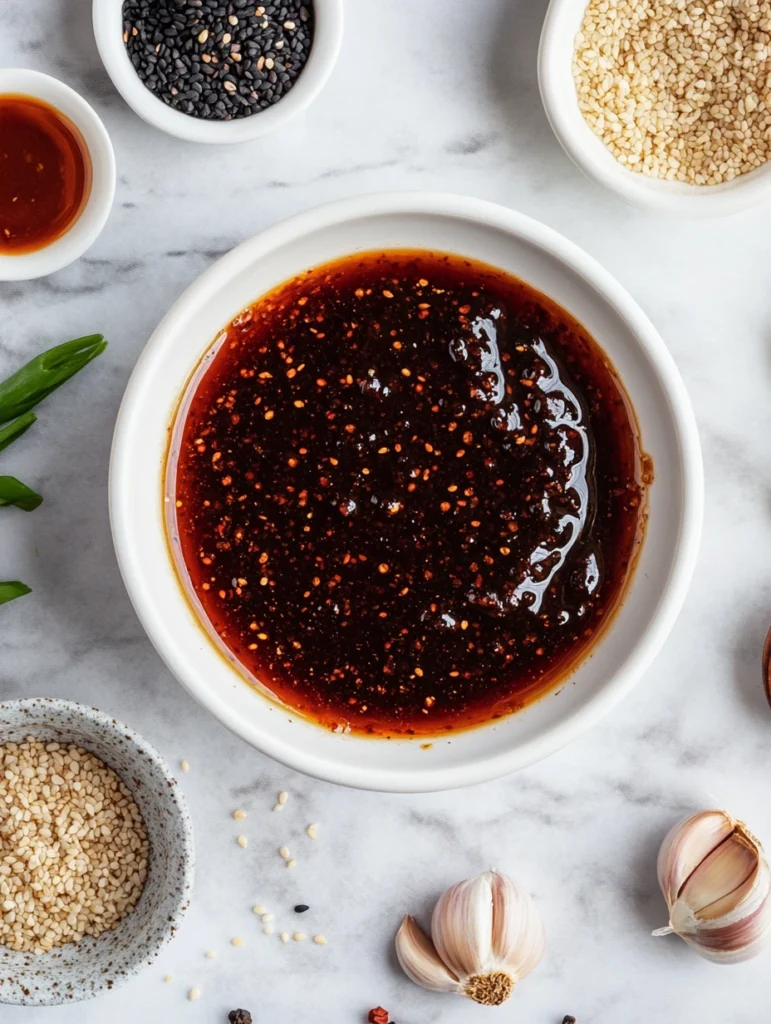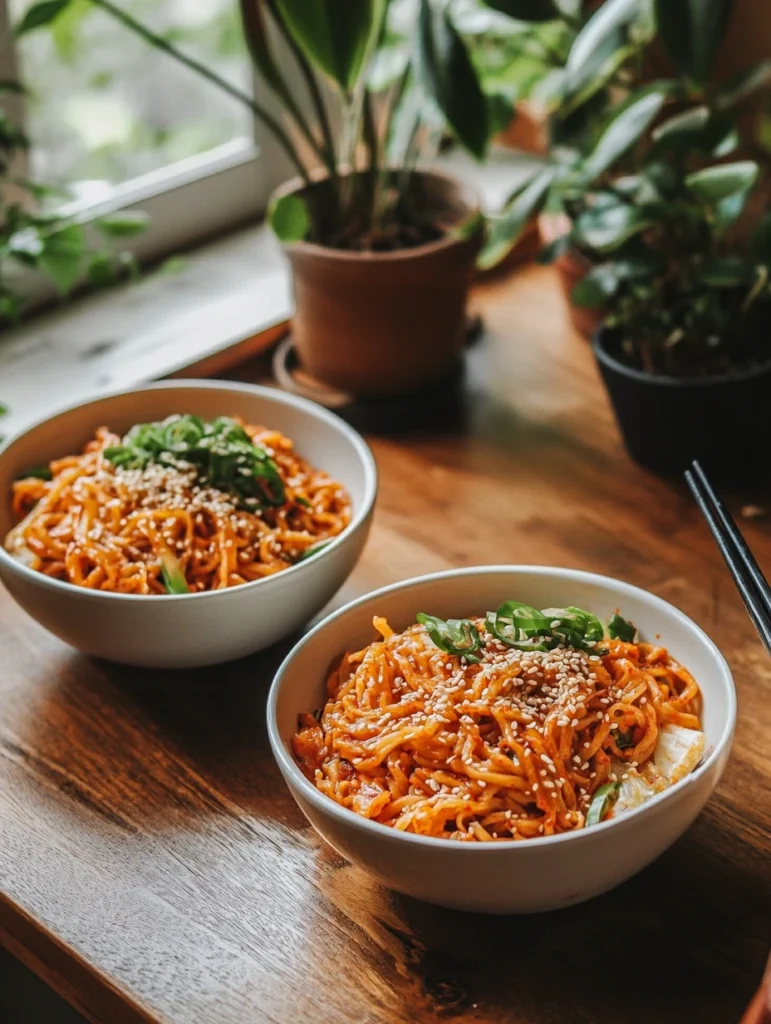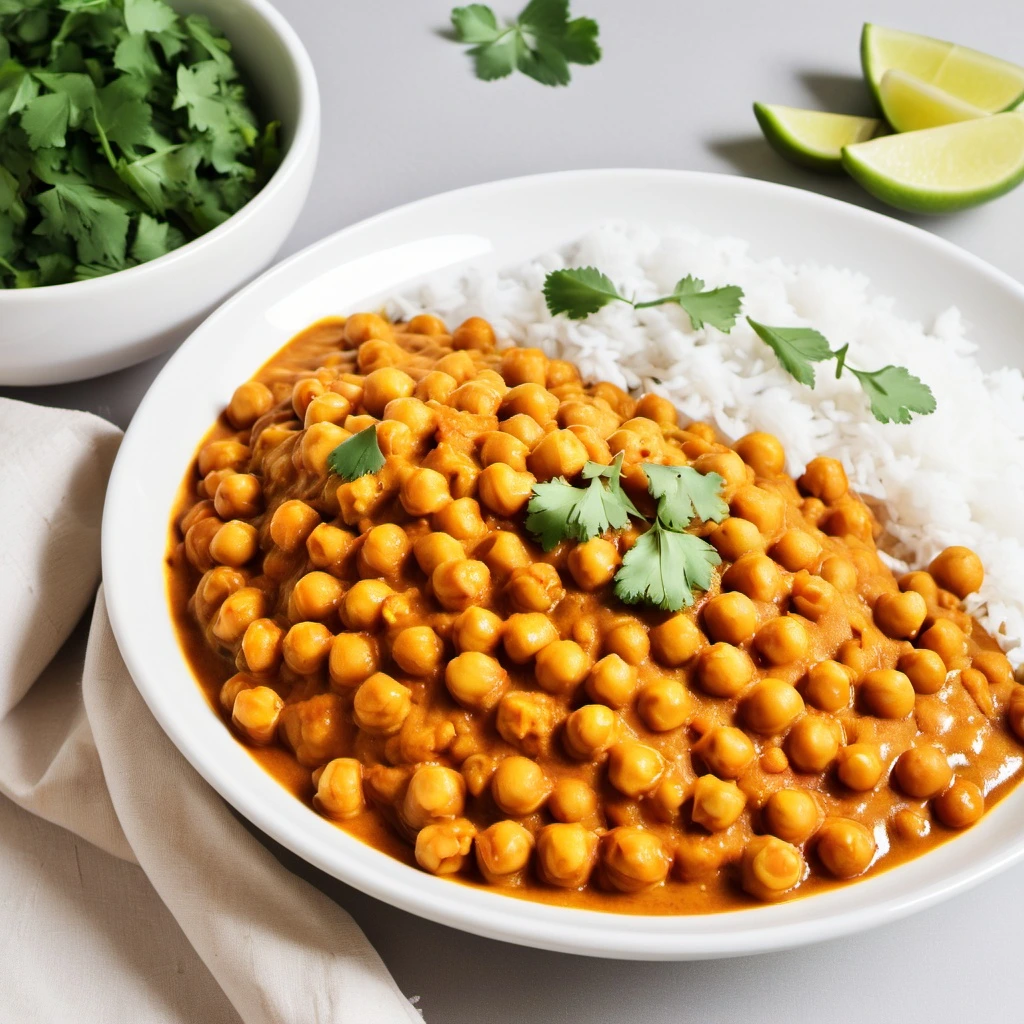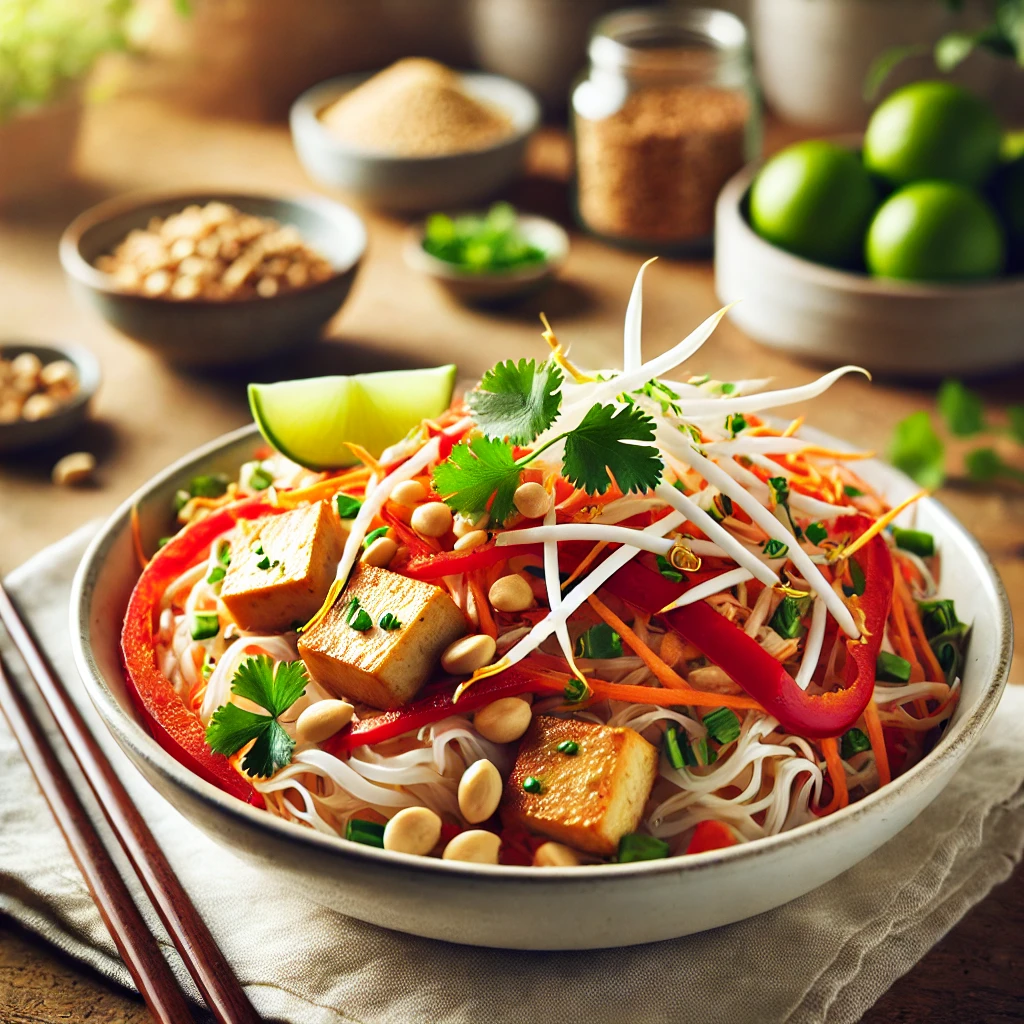If you’re craving something vegan, spicy, and very satisfying, Gochujang noodles are the way to go. Inspired by Korean cuisine, this quick and easy dish stars gochujang—Korean fermented chili paste known for its perfect balance of heat, sweetness, and deep umami flavor.
Ready in just 15–20 minutes, these noodles are ideal for busy weeknights. Plus, they’re completely vegan and endlessly customizable. Add tofu, mushrooms, or your favorite veggies, and you’ve got a simple meal that’s big on flavor and low on effort.
What Are Gochujang Noodles?
The Flavor Profile of Gochujang
If you’ve ever tasted something that’s a perfect mix of spicy, slightly sweet, savory, and a little funky in the best way—chances are, gochujang was involved. Gochujang is a Korean fermented chili paste made from red chili powder, glutinous rice, fermented soybeans, and salt. Over time, the fermentation process develops a rich, deep umami flavor that’s completely unique to Korean cuisine.
This versatile paste isn’t just spicy—it’s layered. You get a slow-building heat that doesn’t overpower but instead enhances whatever it touches. That’s why it works so beautifully in noodle dishes, marinades, dipping sauces, and even soups.
In traditional Korean cooking, gochujang is a pantry staple. It’s the base of iconic dishes like bibimbap, tteokbokki (spicy rice cakes), and kimchi jjigae (kimchi stew). You’ll also find it used as a flavorful punch in Korean BBQ sauces or stirred into gochujang tofu—something you might love if you’re into plant-based meals.
For a deeper dive into gochujang, including how it’s made and where to buy it, this article is a great resource.
Types of Noodles Used in Gochujang Dishes
Now let’s talk noodles—because what’s a spicy sauce without something to soak it all up, right? One of the best things about gochujang noodles is their versatility. You can pair that bold, punchy sauce with just about any noodle variety depending on your taste, mood, or what you have on hand.
- Ramen noodles: Chewy and springy, ramen noodles are a great match for thick gochujang sauce. They absorb flavors well and offer a hearty, satisfying bite.
- Rice noodles: These are naturally gluten-free and lighter in texture, making them perfect for a quick, spicy stir-fry. We love using them in our Tofu Pad Thai too!
- Soba noodles: Made from buckwheat, soba noodles have a nutty taste that pairs surprisingly well with the sweetness of gochujang. Plus, they cook in just a few minutes—ideal for weeknight dinners.
- Udon noodles: Thick and soft, udon is a great choice if you prefer a comforting, slurp-worthy bowl.
Each of these noodles brings a different texture and vibe to the dish, but they all complement the spicy-sweet intensity of gochujang. The sauce clings to the noodles, coating every strand in flavor. Add in some stir-fried veggies or tofu, and you’ve got a balanced, crave-worthy meal that comes together fast.
How to Make Quick Gochujang Noodles
Ready to get saucy? Making Gochujang noodles at home is honestly one of the easiest and most satisfying meals you can whip up. It’s quick, customizable, and bursting with bold, Korean-inspired flavor. Whether you’re new to cooking with gochujang or it’s already a staple in your kitchen, this section will walk you through everything you need.
Ingredients You’ll Need
Let’s start with the essentials. These are the key ingredients that come together to create that iconic sweet, spicy, and umami-packed flavor.
- Gochujang paste – The star of the show. You can find this fermented Korean chili paste in most Asian grocery stores or online. If you’re unsure which brand to choose, Maangchi’s guide to gochujang is super helpful.
- Soy sauce – Adds salty depth and balances the sweetness of the gochujang.
- Garlic and ginger – Freshly minced for maximum flavor. These aromatics are essential for that rich, savory base.
- Sesame oil – A little drizzle of this adds a toasty, nutty finish.
- Noodles – Use your favorite! Ramen, rice noodles, udon, or soba all work wonderfully.
- Scallions – Thinly sliced and stirred in at the end for a bright, fresh note.
- Sesame seeds – For a bit of crunch and subtle nuttiness.
Now, if you want to take things up a notch nutritionally, here are some optional add-ins that pair beautifully with the spicy sauce:
- Tofu – Pan-fried or baked tofu adds satisfying plant-based protein. Check out our Vegan Tofu Pad Thai for another tofu-based winner.
- Mushrooms – Shiitake, oyster, or cremini mushrooms soak up the sauce like a dream.
- Bok choy or spinach – Add a pop of green and a gentle bitterness that balances the heat of the gochujang.
Looking for more easy pantry-friendly meals? You might also love our 5 Easy Vegan Meal Recipes.
Step-by-Step Instructions

Alright, let’s cook! This dish comes together in about 15–20 minutes, making it perfect for busy weeknights when you want something really good without too much effort.
- Cook your noodles: Start by boiling your noodles according to the package instructions. Rinse with cold water if using rice noodles to prevent sticking. Set aside.
- Make the sauce: In a small bowl, mix together gochujang paste, soy sauce, sesame oil, a splash of water (or vegetable broth), and a little maple syrup or brown sugar if you want to tone down the heat.
- Sauté aromatics: In a large pan or wok, heat a bit of oil and sauté minced garlic and ginger until fragrant—about 1 minute.
- Add veggies or tofu (optional): If using mushrooms, bok choy, tofu, or spinach, toss them in now and stir-fry until tender.
- Toss it all together: Add the cooked noodles to the pan, pour in the sauce, and toss everything together until the noodles are well-coated and heated through.
- Finish and serve: Turn off the heat and stir in scallions. Serve hot, sprinkled with sesame seeds, and enjoy!
This method is great because it all happens in one pan, which means fewer dishes (yay!) and more time to enjoy your meal.
Tips for Perfect Gochujang Noodles Every Time

Want to make sure your noodles turn out amazing every single time? Here are a few extra tips:
- Control the heat: Gochujang has a sneaky kick, so if you’re sensitive to spice, start with a small amount and add more to taste. Want it hotter? A pinch of gochugaru (Korean chili flakes) or even crushed red pepper flakes will do the trick.
- Balance the flavors: If your noodles feel a bit too spicy or salty, add a splash of lime juice or a teaspoon of maple syrup to mellow it out.
- Garnish like a pro: Top your noodles with kimchi (if you love fermented tangy heat), extra scallions, toasted sesame seeds, or even crushed peanuts for added crunch. If you’re into fermented foods, you might enjoy pairing it with our Berry Chia Jam Tarts as a sweet dessert to follow your spicy meal.
If you’re looking for more globally-inspired plant-based dishes, don’t miss our Tofu Pad Thai and Vegan Gyros with Tzatziki.
Customizing Your Gochujang Noodles
One of the best things about gochujang noodles is how versatile they are. Once you’ve got that bold, flavorful base sauce, the rest is a blank canvas. Whether you’re keeping it plant-based, going gluten-free, or just tossing in whatever’s in the fridge, there are so many ways to make this dish your own.
Vegan & Plant-Based Options
Good news—this dish is super easy to keep 100% vegan! Gochujang paste is usually plant-based by default, but it’s always a good idea to check the label, as a few brands may sneak in anchovy extract. We like brands like Chung Jung One or Mother-in-Law’s Gochujang for clean, vegan-friendly options (check them out on Korean grocery guides like H Mart).
To bulk up your bowl and make it extra satisfying, toss in some plant-based protein. Here are a few favorites:
- Tofu: Crisp it up in a pan or bake it until golden. It’s perfect for soaking up all that spicy-sweet sauce. You can also check out how we use tofu in our Vegan Enchiladas for inspiration.
- Mushrooms: Shiitake or oyster mushrooms work especially well thanks to their meaty texture and ability to absorb flavor. Sauté them until browned for the best texture.
- Tempeh or edamame: These are great for variety and boost your dish with some added fiber and plant protein.
Looking to lighten things up or avoid gluten? Go with rice noodles or soba noodles (just make sure they’re 100% buckwheat if you need them to be gluten-free). Both work beautifully with gochujang and give the dish a slightly different texture and feel.
And if you’re a fan of high-protein vegan meals, you might enjoy our Vegan Protein Pancakes for breakfast, too!
Add-Ons and Variations for Extra Flavor

Once you’ve mastered the basics, it’s time to play! Adding toppings and mix-ins is where you can really bring your own twist to gochujang noodles.
- Roasted vegetables: Think sweet potatoes, bell peppers, broccoli, or Brussels sprouts. Roast them until crispy and caramelized, then toss them in for added depth and nutrition.
- Kimchi: If you like things tangy and bold, a scoop of kimchi on top adds probiotics and a delightful crunch. Make sure to choose a vegan variety (some include fish sauce or shrimp paste).
- Pickled radish: This Korean side dish, called danmuji, is sweet, sour, and balances spicy gochujang noodles beautifully. It’s easy to find in Korean grocery stores or to make at home.
Want to switch things up completely? Try turning this into a gochujang stir-fry. Just sauté your favorite veggies (carrots, snap peas, zucchini—whatever’s in the fridge) with a splash of sesame oil, toss in your noodles, and stir in the sauce. Add a handful of crispy tofu or tempeh and you’ve got a one-pan meal packed with color, texture, and flavor.
To combine with a tasty vegan dessert, take a look at our easy vegan dessert ideas or our homemade gluten-free vegan tiramisu.
Conclusion
And there you have it—a quick, easy, and flavor-packed dish that brings the bold taste of Korean cuisine right to your kitchen. Gochujang noodles are the kind of meal that delivers maximum satisfaction with minimal effort. In just about 20 minutes, you can whip up a spicy, savory, and slightly sweet bowl of noodles that feels like takeout, but way healthier and totally homemade.
The best part? These noodles are endlessly customizable. Whether you love it simple or loaded with toppings, there’s so much room to play. Try it with crispy tofu, roasted veggies, or a handful of kimchi for extra kick. Don’t be afraid to mix things up and make it your own—cooking should be fun, not fussy.
If you give this recipe a try, I’d love to hear how it turned out! Share your creations on Instagram or Pinterest and tag us so we can see your delicious bowls. Or drop a comment below and let us know what toppings or twists you added—we’re always inspired by your ideas.
Want more plant-based recipes delivered straight to your inbox? Be sure to subscribe to our newsletter for fresh inspiration, seasonal meal ideas, and exclusive content.
Happy cooking—and happy eating!




